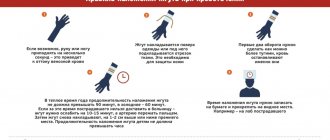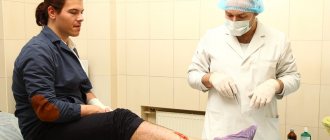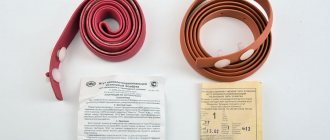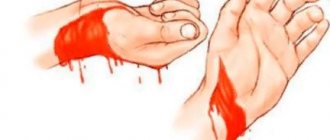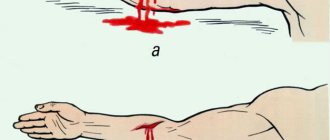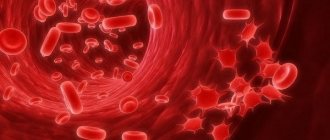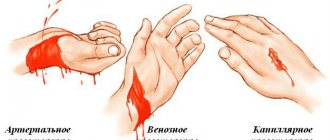Hemorrhage is the loss of blood from the vascular bed as a result of disease and traumatic injury. There are several types of bleeding depending on the type of damaged vessel.
- Arterial bleeding occurs when the integrity of large and medium arteries is disrupted. Blood from the damaged area flows out in a fast pulsating stream, has a scarlet color and leads to a large amount of blood loss in a short period of time.
- Venous bleeding occurs when venous vessels are damaged. The blood is characterized by a cherry coloration and a slow flow from the wound in a uniform stream.
- Parenchymal bleeding is massive blood loss from the vessels of internal organs (kidneys, spleen, liver).
- Capillary bleeding occurs when arteries, small-diameter veins and capillaries are damaged. Blood flows out slowly drop by drop (symptom of “dew”) of a rich red color. Bleeding often stops spontaneously without medical intervention.
Stop bleeding
External bleeding is divided into three types:
- Arterial bleeding - scarlet blood flows from the wound in a pulsating stream
- Venous bleeding - dark blood flows from the wound in a uniform stream.
- Capillary bleeding - blood is released in drops or in the form of “dew”.
The most dangerous bleeding is arterial, because... it leads to rapid loss of a significant amount of blood and is not prone to stopping on its own.
The main task in providing first aid is to temporarily stop bleeding and transport the victim to a hospital, where he will be completely stopped by ligating the vessel, applying a vascular suture, electrocoagulation, etc.
Providing first aid
First aid methods depend on the condition of the body, the nature of the damage, and external conditions. Timely measures taken to stop bleeding prevent the development of undesirable consequences, help maintain hemodynamics (blood movement through the vessels), and maintain the normal functioning of internal organs.
Pressure bandage
The most common method of stopping capillary bleeding is a pressure bandage. Before manipulation, it is necessary to treat the wound with a solution of hydrogen peroxide to destroy pathogenic bacteria and narrow damaged blood vessels. This promotes the rapid formation of blood clots and prevents repeated bleeding when the wound surface becomes infected. The edges of the damaged area of skin are additionally treated with antiseptic substances: iodine, brilliant green, fucorcin.
In case of massive bleeding from small vessels, a pressure bandage should be applied
The application of a pressure bandage occurs in several stages.
- The affected limb should be elevated above the level of the heart to reduce pressure in the bleeding vessels.
- If there is a wound cavity, it is necessary to tamponade it with a sterile bandage.
- Sterile wipes are applied in several layers to the surface of the damaged area of skin.
- Sometimes a roll of cotton wool or a twisted bandage is placed on top (for persistent bleeding).
- The limb or torso is tightly bandaged.
In most cases, debridement and elevated position of the limb quickly stops blood loss. Sometimes, to increase the effectiveness of first aid, the wound is treated with thrombin or gelatin sponge.
To temporarily stop arterial bleeding
First of all, finger pressure of the artery is used. The artery is pressed firmly with your fingers at the site of pulsation, above the wound and preferably in the projection of the underlying bone. For example, in case of arterial bleeding from the lower limb, the femoral artery is strongly pressed at the pulsation point at the level of the inguinal fold. In case of arterial bleeding from the upper limb, pressure is applied in the upper third of the shoulder along the inner surface. After stopping or weakening the flow of blood during finger pressure, you should immediately apply a hemostatic tourniquet, which is usually found in all first-aid kits. The tourniquet is applied above the wound, on top of clothing (or cloth is placed).
The tourniquet must be brought under the limb, stretched strongly, and, without releasing the tension, wrapped around the limb several times. If you don’t have a tourniquet at hand, you can use a strong rope or a trouser belt, etc. In this case, you need to tie the rope around the limb so that some kind of lever (for example, a stick) can be inserted under it. After which the stick is rotated, tightening the rope on the limb until the bleeding stops. A note should be placed under the tourniquet indicating the time the tourniquet will be applied and the victim should be immediately transported to a medical facility. The tourniquet should not be kept tight for more than 2 hours at a time. If during this time the victim could not be transported to a medical facility, the tourniquet should be loosened for a few minutes, after which, if bleeding still continues, tighten again.
Types of bleeding
The type of bleeding depends on which vessel is damaged, in which part of the body it is localized, and the intensity of blood loss.
Classification according to the type of damage to blood vessels:
- capillary bleeding;
- venous;
- internal (parenchymal);
- arterial;
- mixed bleeding.
Classification according to the cause of bleeding:
- abnormal bleeding;
- traumatic.
Classification according to the location of blood loss:
- external;
- internal.
Classification by volume of blood loss:
On average, about 5 liters of blood circulates in the body of an adult. Depending on the volume of fluid spilled, doctors distinguish the following degrees of blood loss:
- mild degree (less than 0.5 liters);
- medium (less than 1 liter);
- heavy (about 1.5 liters);
- massive (about 2.5 liters);
- lethal (about 3 liters), i.e. more than half of the total blood volume;
- absolutely lethal (more than 3.5 liters), i.e. above 60%.
First aid for bleeding is a system of therapeutic and preventive measures that must be taken in case of damage to blood vessels (arteries, capillaries and veins) until qualified medical assistance becomes available. Each type of bleeding has its own characteristics in providing assistance.
Efficiency. Professionalism. Mercy
First aid
trauma, bleeding, blood vessels, emergency medical care
In the next issue of “First Aid,” Oleg Nesterov, head of the quality control department for medical care at the Tyumen ambulance station, will tell you how to properly provide emergency care for bleeding.
Types of bleeding: different approaches
There are three types of bleeding: capillary, venous and arterial. How can you distinguish them visually? With capillary bleeding, droplets of blood appear on the surface of the skin. With venous, blood flows in a stream, like from a tap. But the most dangerous, life-threatening bleeding is arterial. Its main symptom, regardless of the color of the blood, is pulsating, in the rhythm of the heartbeat, in jerks. Often, with arterial bleeding, a blood ridge is formed, which can be compared to how geysers shoot out of the ground. But even this bleeding can be stopped.
Stopping methods: holding the wound tightly
There are several methods to stop bleeding. An emergency stop is digital pressure on the vessels in the wound. But it is advisable to somehow protect yourself. The simplest thing is to put any plastic bag on your hand like a glove. With a hand, a fist, or at best, of course, a rolled up bandage, the wound must be pressed down with force until the bleeding stops. And then you can call for help, look for a tourniquet, call an ambulance. It should be noted that clamping a wound is not an easy task; it will take a lot of effort.
Neck – any folded fabric will do for this. We hold the wound tightly. We clamp one artery and leave the trachea free. Bleeding often cannot be completely stopped, but it can at least be slowed down.
There is an artery in the axillary region - you need to feel it with your fingers, then just take the entire inner area of the shoulder and press firmly with your hands to the bone, and below the bleeding will stop.
Under no circumstances should you open your hand from the wound. If you feel tired, you need to either help yourself with your other hand, or ask for help - so that someone else presses on your hands from above.
In case of internal bleeding, the main task is to get the patient as quickly as possible to where there is a surgeon and an operating table. The only thing you can do if there is bleeding in the abdomen is to press hard on it with your fist. Signs of internal bleeding: there is a wound, the person is pale, and has a rapid heartbeat.
Cold stops only capillary bleeding. For arterial blood, cold is useless.
Applying a tourniquet: focusing on blood flow
If the wound is on the neck, where the largest carotid artery is located, then a tourniquet cannot be applied. But you can fix the bandage through the arm opposite to the wound.
The points for applying the tourniquet on the limbs are the middle or lower third of the shoulder. Accordingly, a tourniquet is also applied to the thigh.
When applying any tourniquet, the bleeding should stop!
For wounds on the extremities (pink stickers on the layout indicate bleeding areas), a tourniquet is applied above the wound. When bleeding in the neck and head area, the artery is pinched below the wound. The explanation for this is very simple - arterial blood flow comes from the heart.
The tourniquet is stretched, applied to the limb, the ends are crossed, fixed with a finger and wrapped again with less force. Similarly, bleeding is stopped using a belt and other suitable means at hand.
The biggest mistake is when a tourniquet is applied for venous bleeding (although it would be enough to apply a tight bandage), but they do it weakly; as a result, the blood flow not only does not slow down, but becomes stronger. Important: when applying any tourniquet, the bleeding must stop! It is this sign that indicates that the rescue actions were completed correctly.
After 15 minutes, loosen the tourniquet without removing the first round, and when bleeding resumes, tighten it again. During this time, it is guaranteed that necrosis of the limb tissue will not occur.
Another way to apply a tourniquet is twisting. You need a tourniquet (thin scarf, bandage, lace, any elastic fabric, etc.) no less than the length of your arm. But someone else must run for the rope and stick, since the wound of the victim cannot be let go for a second. We wrap the tourniquet around the limb twice, tie a knot, tighten it, leaving the finger under the bandage. Then insert a pencil or similar object under the top of the bandage and twist it until the bleeding stops. Once the bleeding has stopped, the pencil should be securely fastened.
Elena SIDOROVA, specially for 72.ru
Emergency care for capillary bleeding
With capillary bleeding, an infection can enter the human body through the wound. To prevent this from happening, the wound must be treated and bandaged.
Algorithm for providing assistance:
- If the wound is dirty, it should be washed with water;
- Treat the wound with hydrogen peroxide;
- Apply a bandage to the wound or place an antibacterial patch over the wound.
Nosebleeds can stop on their own, but in severe cases first aid must be provided:
- Sit the victim down with his head slightly forward and let the blood drain.
- Apply cold (ice, cold pack, etc.) to the bridge of your nose.
- Press the wing of your nose against the nasal septum - the bleeding should stop within 10 minutes.
- If this does not happen, rolled gauze swabs must be placed in the nasal cavity. If bleeding in this case continues after 10 minutes, send the victim to the hospital.
